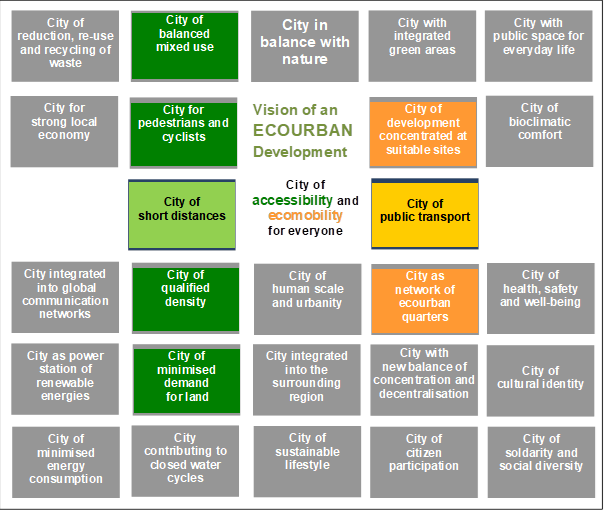The vision of sustainable and liveable settlements (cities and towns) for the future
Considering the long lifespan of built structures, settlement patterns for the future (ECOURBAN development) need to be sustainable in the original sense, in order not to jeopardise the basis of existence for future generations. This includes ensuring the availability of the resources land, energy and materials as well as the preservation of the natural environment – thus impairment of the environment and resource use have to be minimised. But settlement patterns fit for the future also need to provide a high quality of life for the present generation – in other words, the liveability of ECOURBAN Settlements should be maximised
To illustrate the ECOURBAN vision, the features of a community, which would fulfil these goals, were brought together in the Figure below. Agreeing on such a vision of the final aim is helpful when discussing and agreeing on the steps and measures that need to be taken along the way. It can also help in promoting overall awareness of the idea of ECOURBAN Settlements. The building blocks of this vision are not ranked in any particular order of importance, as all are required to reach the goal while their relative contribution varies from case to case.

The term “City” in the figure can be replaced also by “Towns”, which are at least as important, but often neglected.
Due to the close interrelations of transport with other sectors, especially the urban structure, minimising transport demand is a key element in fulfilling the vision: it contributes to minimising material and energy consumption (for motorised means of transportation) as well as to minimising the impairment of the natural environment and also the impairment of people’s health and safety (caused by transport, predominantly car-traffic). This in turn increases human well-being. The city/town of short distances – the appropriate urban structure for minimising transport demand – is thus a central feature of the ECOURBAN vision. It is a main requirement for maximising the accessibility of various destinations and thus maximising mobility for everyone. The sustainable mode for longer distances, public transport, especially on rails, makes additional demands actually on the spatial development: quarters of short distances around public transport stops should be located preferably in rail corridors (city/town of public transport).
The requirements connected with the City of short distances and the City of public transport are marked in the figure in different colours.